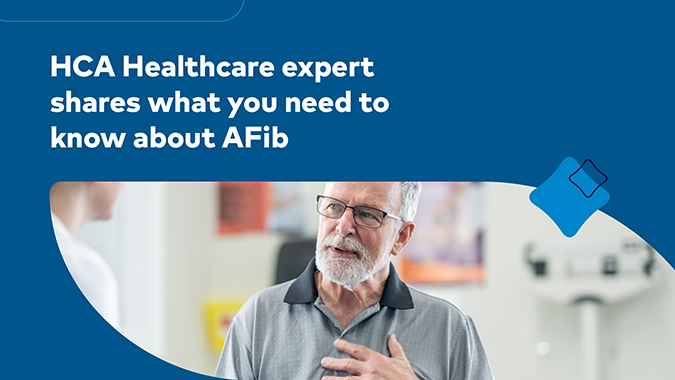

Atrial fibrillation, commonly known as AFib, is the most common arrhythmia. People living with AFib are at increased risk of stroke, heart failure, and other health concerns. The Centers for Disease Control and Prevention (CDC) and the American Heart Association predict that more than 12 million Americans will have atrial fibrillation by 2030.
If you know someone who has been diagnosed with AFib, or if you suspect that you or a loved one may have AFib, keep reading. Dr. Jose Osorio, board-certified clinical cardiac electrophysiologist and medical director of HCA Florida-Miami Electrophysiology, explains what atrial fibrillation is and shares his hopes for future treatments. Dr. Osorio is the principal investigator of several clinical trials investigating new treatment options for atrial fibrillation.
Question: What is AFib and what does it feel like to have it?
Dr. Osorio: AFib is a type of arrhythmia in which the upper chambers of the heart, the atria, lose their normal electrical activity and begin to tremble. As a result, the heart beats very fast and cannot pump blood effectively, causing a variety of symptoms. Blood also collects in small sacs called appendages where blood clots can form, increasing the risk of stroke by five times. Additionally, strokes caused by atrial fibrillation tend to be more severe than strokes caused by other causes.
The most common symptoms of AFib are fatigue and heart palpitations. Other symptoms include:
Fast and irregular heartbeat Shortness of breath Anxiety General fatigue or fatigue when exercising Dizziness, fainting, confusion, or weakness Chest pain or tightness
Some people with AFib have no symptoms. Therefore, it is important to have your heart checked regularly, even if nothing seems to be wrong.
Question: How is AFib diagnosed?
Dr. Osorio: When I evaluate a patient who may have atrial fibrillation, I start with a medical history, physical exam, and electrocardiogram (ECG). In some patients, symptoms may come and go (paroxysmal atrial fibrillation), making diagnosis more difficult. Others are always in atrial fibrillation, which makes diagnosis easier (persistent atrial fibrillation).
If atrial fibrillation is not detected during the examination, the patient is usually sent home with a heart monitor that records every heartbeat for a week or more. In some cases, an implanted heart monitor is used for diagnosis.
These tests can help diagnose and choose the best treatment, including medications and procedures.
Visit the American Heart Association website for a downloadable Partner in Care guide to help you discuss your heart health and options with your doctor.
Question: Who is at risk for AFib and what are the risk factors?
Dr. Osorio: Anyone can get atrial fibrillation, but it's more common in people who have the following symptoms:
Older age Alcohol use (moderate to heavy binge drinking) Family history of atrial fibrillation High blood pressure (main cause) Obesity Sleep apnea Chronic conditions such as underlying heart disease or diabetes
Lifestyle changes can help reduce your risk of developing atrial fibrillation and improve its control if you already have it.
Participate in regular physical activity Eat a heart-healthy diet low in salt, saturated fat, trans fat, and cholesterol Manage high blood pressure Avoid excessive alcohol intake Don't smoke Manage cholesterol levels Maintain a healthy weight
Question: Can AFib go away on its own?
Dr. Osorio: AFib usually does not resolve on its own. Most patients begin with sporadic episodes that gradually increase in frequency and duration. However, you can slow its progression by leading a healthy lifestyle.
Suppress the progression of AFib and improve the effectiveness of treatment.
Question: What treatment options are available for people diagnosed with AFib?
Dr. Osorio: We now have a wide range of treatment options for patients.
The main goals of treatment are to prevent stroke and other complications and improve quality of life. We use anticoagulants for patients at risk for stroke and provide left atrial appendage closure devices for patients who cannot take anticoagulants.
We also perform procedures to treat and, in some cases, eliminate arrhythmias. Atrial fibrillation ablation is a procedure that attempts to eliminate the signals that cause and maintain AFib. A new technology called pulsed-field ablation (PFA) has revolutionized AFib ablation. PFA uses new non-thermal energy to treat AFib without damaging surrounding tissue. It is safer and more efficient and allows the procedure to be performed under sedation instead of general anesthesia.
We also encourage patients to visit the American Heart Association's My AFib Experience website. This online community allows individuals with AFib and their loved ones to share their stories and find support.
Question: What are your hopes for the future of AFib treatment?
Dr. Osorio: In addition to traditional treatment options, continuous innovation in the ablation field continues to bring new technologies. At HCA Healthcare, we are proud to participate in several clinical trials exploring new treatments for atrial fibrillation.
We are currently participating in nearly a dozen AFib clinical trials across our organization, many of which I am leading as principal investigator. Clinical trials play an important role in developing safe and effective treatments for a variety of conditions, including atrial fibrillation. We are committed to advancing atrial fibrillation treatment and improving outcomes for patients around the world.

